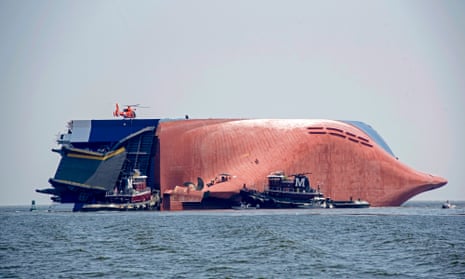
From the Ever Given blocking the Suez, to the Costa Concordia cruise ship hitting a reef, what exactly do you do when a vessel comes to grief – and how do you prevent catastrophic pollution?
At 3:24am in the Atlantic Ocean, a catastrophe unfolds across the moonlit waters. The MS Seascape – a 200-metre, six-storey cargo vessel carrying 4,000 new electric vehicles – is pushed by swells into a coral reef. The ship grinds to a sickening halt, begins listing violently to the side and capsizes on to the reef a few kilometres from port.
The coastguard receives the distress call. Helicopters lift the flailing crew members to safety, while support boats unload any cargo that hasn’t already tumbled into the sea. It’s urgent – lithium ion batteries in electric cars risk exploding and most of the vehicles are stored in the hold. If fire breaks out, the vessel will become a giant pressure cooker.
Although our MS Seascape is a hypothetical ship, its situation is far from uncommon. In 2021, 54 large vessels either sank, ran aground or went up in flames and these behemoths are more likely to cause catastrophe when things go wrong.Q&A
Abandoning the ships is rarely an option. The risks of oil and fuel leaks mean it is now standard practice to try to salvage them and fix any environmental damage. But the costs are astronomical: the Costa Concordia, which ran aground off Genoa, Italy in 2012, became the most expensive wreck removal in history, costing more than $1bn, and taking 350 salvage workers almost three years.
There’s no cookie-cutter approach to salvage: each operation will vary depending on location, water depth, weather, equipment and sensitivity of the surrounding environment.
So what to do with our hypothetical MS Seascape? Let’s get started.
Step 1: Contain spills and remove fuel
https://interactive.guim.co.uk/uploader/embed/2022/11/seascape-salvage_1_nohead/giv-6562aWQ3ApXJ2QrV
The risk posed by MS Seascape, loaded with potentially explosive car batteries, is not dissimilar to that of the 200-metre Felicity Ace, which caught fire in the mid-Atlantic before sinking to an unsalvageable 10,000ft: it is suspected that the 281 EVs onboard may have sparked, or at least accelerated, the blaze.
To avoid this fate, a local salvage company gets involved, one of a few dozen operators around the world poised to rush to the scene of a maritime disaster. Its first objective is to save the vessel and return it to service.
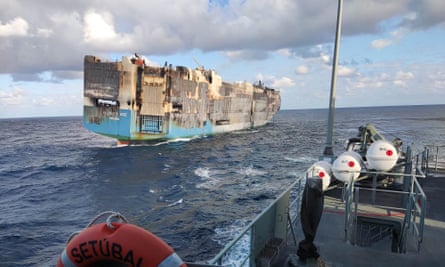
A vessel’s location has a huge bearing on how quickly the operation unfolds. The Rena, a container ship that grounded off the coast of New Zealand, had to wait several weeks for equipment to arrive from Singapore – during which time the hull broke apart.
At this stage it is too early to tell how much impact the MS Seascape hull has sustained. In the morning, in calmer conditions, the salvage crew traces a skirted boom around the vessel to capture any fuel and hazardous wastes.
In the meantime, a specialist team begins bleeding its 20-plus tanks of more than 300,000 gallons of fuel, as well as potential pollutants such as lubricants, gases and oily water and sludge.

They drill through the ship’s exposed double-walled steel exterior into the fuel bunkers below, inserting pipes to pump out waste to a waiting vessel. Divers are dispatched to enter the ships’ interior to drain the remaining submerged tanks. This is a delicate task: removing fuel can destabilise the already precarious ship, so this process can take days, possibly weeks.
Suddenly, a crisis: after days of being strained against the reef by the current, stress fractures appear along the hull. They could break the ship apart. This dashes hopes of returning the MS Seascape to service – the cost of recouping would now be more than the value of the ship itself.
The mission transitions from salvage operation to wreck removal and the real work begins.
Step 2: Slice the ship apart
After 10 days, the ship’s fractures threaten to split the wreck. The team of hundreds of engineers, crane operators, firefighters, labourers, divers and architects, must move quickly.
They cut away the accommodation block to declutter the deck and simplify the process. One option to break the ship is to use explosives, such as those applied to the MSC Napoli, a giant container vessel grounded off England’s south coast in 2007 and blasted into two sections. But this would be catastrophic for the fragile coral ecosystem beneath the wreck.
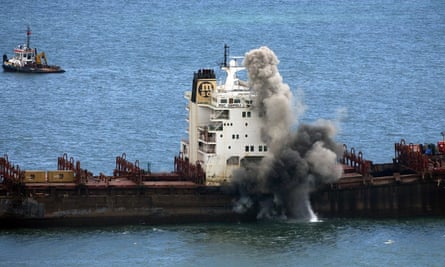
Instead, the removal team opts for a thick cable of diamond-encrusted wire that can slice through inches-thick steel. The saw is fitted into a custom-built frame lifted by cranes and ferried to the wreck site. Over two days, its two legs are rigged into the seafloor on either side of the wreck. Within the frame, the wire is cycled at high speed through a system of pulleys and lowered, guillotine-like, into the metal hulk, shearing through it with an ear-splitting roar.
It can take up to 12 hours to cut a single cross-section, but the saw’s surgical precision means it only grazes the reef below. It can also slice between parked cars in the lower decks so that fewer tumble out into the sea, and around the fuel tank.
Fuel isn’t the only environmental threat: ships contain an extraordinary load of hazardous material, such as antifouling chemicals and lead embedded in paint, asbestos in the walls, and mercury and polychlorinated biphenyls (PCBs) wound into the electrics of older ships. These pollutants will gradually ooze out of hulks left to rot in the ocean. One sunken German warship is still leaching chemicals into the North Sea after more than 80 years.
Step 3: Remove sections and take them ashore
https://interactive.guim.co.uk/uploader/embed/2022/11/seascape-salvage_3_nohead/giv-6562fJnzpo29On1k
The MS Seascape is now encircled with vessels and equipment ready to intervene as pieces of the wreck are shorn off. With the ship’s bow resting on the reef, but its stern threatening to fall to the ocean floor when cut loose, the team has a two-pronged plan.
First, the floating sheerleg: a huge crane on a buoyant platform, capable of lifting 7,000 tons. It is a mechanical island with an accommodation block for the dozens of workers who will be at sea for weeks dismantling the wreck.
The crew will slice the ship into eight pieces. Starting with the bow, each slice is drilled with holes through which cables are threaded, then hoisted up by crane. Piece by piece, the ship is carefully loaded on to waiting barges and ferried away.
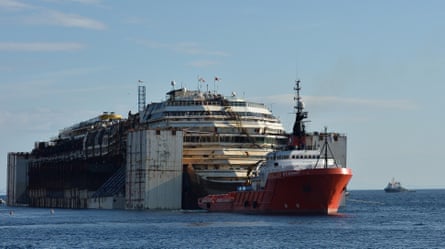
The stern requires a different approach. Before the rear segment is cut free, support vessels weld enormous air-filled metal boxes called caissons to its exposed starboard side. These are partly filled with water, adding weight that rotates the stern upright when it is cut free. As the stern is righted, caissons are attached to its port side, too. On both sides these are filled and emptied of water, to reach the perfect level of buoyancy to keep the stern afloat. Once free and released on to the water, the stern is then tugged to port.
Not all wrecks would need the same approach. Some with relatively minimal damage, such as the Costa Concordia, can be patched up, fully refloated with caissons, then towed away. Others have to be dredged up from the seafloor, such as the X-Press Pearl, whose nitric acid load caught fire off Sri Lanka in 2019 and caused the ship to sink to 68ft – along with its cargo of 50bn plastic “nurdles”, which swamped Sri Lankan beaches.
The X-Press Pearl needed dozens of cables to winch it up from the seafloor, but the monsoon season stalled the mission, dragging out a process already costing the vessel owners $40m in environmental compensation claims from the Sri Lankan government.
Even with a well managed wreck such as the MS Seascape, some spillage is unavoidable. Divers, aided by remotely operated underwater vehicles, locate lost cars and other metal debris, feeding this information to a barge fitted with underwater magnets and mechanical grabbers.
Two months after the ship ran aground, no trace remains of the MS Seascape in the ocean – but the work continues.
Step 4: Strip down the ship
Back on land, the pieces of the MS Seascape wait to be broken down. The vessel was flagged to the EU, meaning it must be dismantled in one of 46 regulated yards spread across Europe, Turkey and the US.
This means it will be dealt with under stricter requirements than vessels in south Asian shipbreaking beaches, where 70% of global ships end their seagoing lives. Looser regulations in these locations result in dozens of labourer deaths annually, and untold environmental impacts as pollutants leach on to beaches and into the sea.
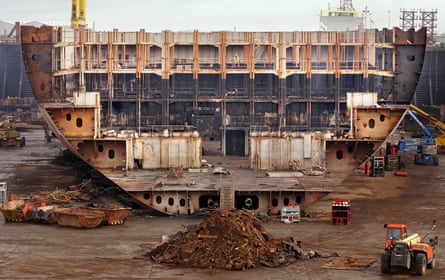
However, at the dry dock in Italy where most of the MS Seascape ends up, waste is supposed to be contained. Over several months, the ship is stripped back to basics: sheets of asbestos, wiring, equipment and furniture are removed until only the steel husk remains.
This is where most of the ship’s value now lies. Efficient smelting operations can recycle almost all a ship’s steel: about 90% of the material in the Costa Concordia was recycled.
Back on the reef, rehabilitation has begun. The water is monitored for residual pollutants, and teams begin planting nursery-grown coral into the shattered reef. This will take years: a decade after the Costa Concordia capsized, damaged seagrass meadows are still being restored.
Now reduced to molten steel, some of the MS Seascape might be forged into yet another ocean-going colossus. As shipbuilding ingenuity grows, so will the effort, costs – and the innovation – required to salvage these leviathans at sea.
The Guardian – January 11, 2023
